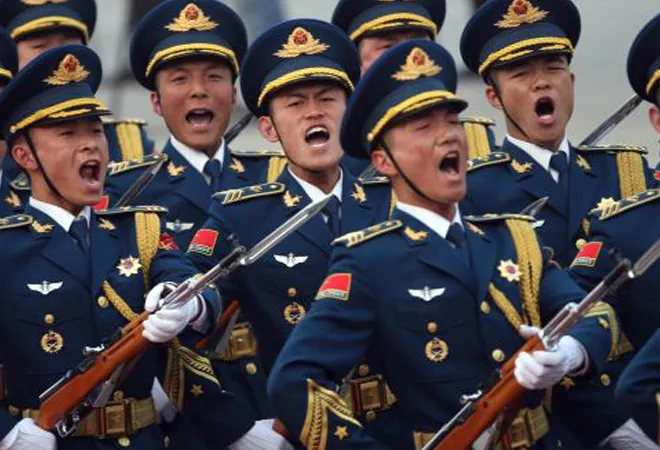
China’s ‘New Silk Route’, a geo-economics project which was inaugurated in 2013, seeks to economically and physically link China to markets in Central Asia, Europe, the Middle East and South Asia. However, as China expands its economic footprint globally, it is increasingly exposed to the threat from Islamic terrorism at home and abroad. One of the areas in which the BRI project faces security challenges is the volatile ‘Af-Pak’ region which is rife with local, regional and global terrorist groups. Beijing has therefore been actively collaborating with neighbouring countries on counterterrorism, seeking to co-opt and strengthen local forces to protect Chinese projects and interests. This policy has led to greater security cooperation, especially with countries like Pakistan. Beijing is now extending this approach to secure assets and interests elsewhere. In Afghanistan, China has been expanding its diplomatic, economic and security profile over the last few years. China’s engagement in Afghanistan is however not limited to the Afghan government as it has also established strong relations with the Taliban. Clearly, China’s security agenda is taking precedence over its projection of being a reliable development partner especially in the Af-Pak region.
China’s terrorism concerns were primarily domestic and came from the East Turkestan Independence Movement (ETIM).
China has not been immune to the ‘three evil forces.’ Arising from ethnic tensions between the Han Chinese and Uighur Muslims in the region of Xinjiang since the 1990s, the insurgencies were labelled as social unrest prior to 2001. After 9/11, the Chinese rebranded the incidents as terrorist attacks and retrospectively portrayed itself as a victim of terrorism. Hence there was a shift in public discourse on the ethnic uprisings. The Chinese viewed the insurgency in Xinjiang as religious extremism which was motivated, triggered and inspired by overseas terrorist organisations. China’s terrorism concerns were primarily domestic and came from the East Turkestan Independence Movement (ETIM). Over the years, however, ETIM has garnered support from terror outfits like Tehreek-e-Taliban Pakistan (TTP), al-Qaeda and the Islamic State (ISIS). Most of these terror groups have threatened to target Chinese nationals in response to Beijing’s treatment of Chinese Muslims and its increasing foothold in Pakistan.
The ‘Af-Pak’ region is home to the flagship project of the BRI ― the China-Pakistan Economic Corridor (CPEC). In the last decade CPEC has bolstered relations between Beijing and Islamabad. Over the last three years China and Pakistan have worked to expand the BRI to Afghanistan given its strategic location which provides the shortest access to Central Asia. The Chinese have even been able to bag a seat in the Afghan Peace Talks thanks to their ‘iron brother’ which makes them a major stakeholder in the effort to stabilise Afghanistan. China has also proactively collaborated on counterterrorism with Central Asian nations neighbouring the Af-Pak region. Central Asia was traditionally considered as being in Moscow’s sphere of influence. Beijing has however gradually increased its presence using the five pillars for engagement; the Shanghai Cooperation Organisation (SCO), training and joint exercises, military aid, military sales, and private security companies (PSCs). Xi Jinping’s speech announcing the BRI in Kazakhstan is indicative of the importance of Central Asia in China’s security calculus.
China has also proactively collaborated on counterterrorism with Central Asian nations neighbouring the Af-Pak region.
Adopting a new strategy towards security on its Western border, the Chinese undertook the leadership in the Quadrilateral Cooperation and Coordination Mechanism (QCCM), a multilateral security cooperation framework composed of Afghanistan, China, Pakistan and Tajikistan (countries known to be vulnerable to terrorist attacks). This is an unprecedented initiative by the People’s Liberation Army (PLA) where there is intelligence cooperation and military-to-military exchanges between the partner nations in the context of terrorist threats. In 2017, there were reports about the presence of Chinese security forces patrolling the Wakhan Corridor in Afghanistan which borders the province Xinjiang. While Beijing claimed that the troops were only engaged in ‘joint counter-terrorism operations’ with Kabul, the presence of these troops suggests a broader shift in Chinese policy towards the region and the role of BRI. In the broader region of Central Asia-Afghanistan-Pakistan, China’s primary security concerns revolve around curbing increased Islamisation of Chinese Muslims and any support to Uighur militancy. To ensure this, Beijing has injected an anti-Uighur thrust into its ‘Good Neighbours Policy’ agreements and the larger counter-terrorism rubric under the SCO.
The NATO withdrawal from the region has pushed China to actively engage with Afghanistan. This shift was prompted by the growing threat from the Islamic State group which issued its first direct threat to Beijing in 2017, in a video where Chinese Uighurs vowed to return home to carry out attacks and also established its Khorasan Province offshoot in the country. Chinese military involvement in Afghanistan although limited in comparison to the United States has since seen an increase. It has also been stated by former Afghan officials of the Ghani administration that China has sought to build a military base in Badakhshan province’s Wakhan Corridor and deploy a PLA brigade, in addition to offering to send mentors and trainers for Afghan forces. The Chinese refused the Afghan government’s request for Russian helicopters and instead pushed for Chinese helicopters and drones along with deploying Chinese internet and navigation systems that rival the American-built Global Position System (GPS). The Afghan government nonetheless resisted the proposal due to fears of Chinese systems being used to spy on Afghanistan and its allies like the US. Similarly, China has used its influence in Islamabad, augmented through the BRI to push Pakistan into using Chinese intelligence, navigation and military equipment. For China and its growing global ambitions, the Af-Pak region has taken significant precedence in its security calculus for its counterterrorism objectives as well as assuring safety for its BRI investments in the region.
This is an unprecedented initiative by the People’s Liberation Army (PLA) where there is intelligence cooperation and military-to-military exchanges between the partner nations in the context of terrorist threats.
Measured purely in economic terms, Beijing’s activities in Afghanistan shows how little it has done to justify the BRI narrative. The most substantive Chinese engagement in Kabul has been border control measures aimed at preventing infiltration of terrorists. Although China rarely advocates about expanding security ties with other countries, recent trends indicate otherwise. President Xi Jingping has systematically accelerated the transformation of China’s national defence policy from a regional to a global security posture as he set the goal for PLA to become a world-class force by 2050. This leads to the increasing possibility of future Chinese military operations in BRI partner nations in the defence of Chinese nationals and investments. According to Dr Mathieu Duchâte, Director of the Asia Program at Institut Montaigne, the Chinese have defined the nature of overseas military operations. One of them being a greater presence and military posture in Central Asia and the Af-Pak region. The Chinese adopted their first counterterrorism law in 2015, in which Article 71 addresses overseas operations. It sets the stage for the People’s Armed Police (PAP) to carry out missions abroad stating: The Chinese People’s Liberation Army and Chinese People’s Armed Police (PAP) may assign people to leave the country on counterterrorism missions as approved by the Central Military Commission. It can be argued that there is a lack of institutionalisation for China’s approach to overseas missions however, the country’s expanding global footprint through the BRI provides a strong incentive for it to strengthen and use its military posture.
Apart from the importance of safeguarding CPEC, Beijing's approach to Af-Pak can be attributed to its growing geostrategic interest in South Asia and the Indo-Pakistani rivalry. Further, the ‘all-weather’ friends’ interests converge due to their mutual hostility towards India and challenge New Delhi’s influence in South Asia. For China a cooperative Pakistan contributes to intelligence and policy support for the crackdown on Uighur Muslim terrorists along with denying refuge to them in Afghanistan. Pakistan is a key player in Afghanistan and China’s leaders recognise its utility to counter the threat posed by radical Islamic terrorists. Many key actors in Afghanistan had hoped the Chinese would pressurise Islamabad to give up its duplicitous policy of using proxy groups. But contrary to expectations, Pakistan has convinced Beijing that it would prevent the terrorists working against China and neutralise any groups that harboured and supported Uighur Muslims. With China’s increasing focus on counterterrorism in its neighbourhood and strengthening of its ties with its ‘iron brother’, Beijing has constantly displayed its support for Pakistan. The Chinese have also benefited from engaging with the Taliban as like Pakistan and Saudi Arabia, there has been deafening silence from the Taliban on the Chinese state’s treatment of Uighur Muslims.
For China a cooperative Pakistan contributes to intelligence and policy support for the crackdown on Uighur Muslim terrorists along with denying refuge to them in Afghanistan.
With Beijing beefing up its security presence in the volatile region to prevent instability from spilling over from Afghanistan into countries like Pakistan and then into Xinjiang, China’s security interests are dictating its expanding footprint ― both economic and military ― in the region, and with it its increasing assertiveness in the Af-Pak region. Unchecked Chinese influence in India’s extended neighbourhood coupled with the potential of Chinese troops being stationed in the region poses serious challenges to New Delhi.
The author is a research intern at ORF.
The views expressed above belong to the author(s). ORF research and analyses now available on Telegram! Click here to access our curated content — blogs, longforms and interviews.




 PREV
PREV


